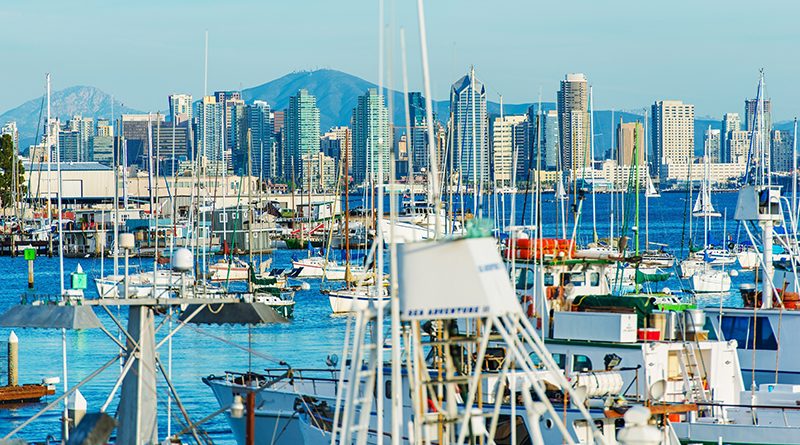Solution for Reduction of Copper Loading in the Water Column for Shelter Island Yacht Basin (And Marina del Rey plus Newport Bay)
SAN DIEGO— A comprehensive article by Jordan B. Darling in the July 22 – Aug. 4, 2022, issue of the Log discussed the challenges associated with reducing the copper loading in the water column of boat basins with a heavy concentration of recreational vessels. Passive leaching of the antifoulant, cuprous oxide (Cu20), from boat bottoms is the problem. It has been over a 20-year effort, with only partial success. The initial copper loading measurement (total maximum daily load, or TMDL) was 8.3 ug/liter and has only been reduced to 6.1 ug/liter in recent years. Not much progress has been achieved since. The required goal is 3.1 ug/liter TMDL.
BACKGROUND: Tributyltin was the FIRST-GENERATION bottom paint back in the 1970-80s until it was outlawed as too toxic. Copper bottom paint followed as the SECOND-GENERATION and has done an excellent job of warding off hard marine growth on boat bottoms over the ensuing years by leaching (Cu2O) as a pesticide. However, the State of California Department of Pesticide Regulation (CDPR) and EPA have found it harmful to juvenile marine organisms’ growth.
Microbes, which serve as the base of the marine food chain, form a biofilm on a clean boat bottom, and algae follows to feed on them. Hard marine growth, such as barnacles and mussels, then attach to feed on the algae. This hard marine growth fouling affects a boat’s speed and fuel efficiency as it proceeds through the water. The obvious solution is to stop the biofilm from forming.
RECENT HISTORY: Several years ago, an ingredient was developed under a DoD contract award to fight Anthrax. It involves the generation of an “ion field,” which in turn forms a low-voltage shield on the surface. This low voltage shield wards off Anthrax spores, or microbes, thus disrupting further disease development.
The same “ion field” concept is now available in a new antifoulant bottom paint for use by both recreational and commercial vessels. The ingredient involved, once again, is cuprous oxide. However, it has been specially treated to combine with a ceramic epoxy (polymer) coating that encapsulates it within a ceramic shell. This ceramic shell prevents it from leaching, as determined by a certified marine testing laboratory. The result is a strong “ion field/low voltage shield” that repels marine microbes. The “ion field” is formed by the unbalanced cuprous oxide molecules called ions.
A major oil company became aware of this special “ingredient” and asked a Texas company, CeRam-Kote Coatings, Inc., to formulate it in their ceramic polymer coating to protect underwater fittings on their offshore oil platforms in the Gulf of Mexico. It worked!
And so, a THIRD-GENERATION bottom paint was developed. It’s another case of a breakthrough in one industry becoming useful in another.
CURRENT STATUS/SOLUTION: This new bottom paint, called CeRam-Kote AF Marine (CK-AF), is now available through local boatyards and is in the process of being registered with EPA. It offers several advantages over copper bottom paint besides not leaching. The current leach rate accepted by CDPR is 9.5 ug/cm2/day. CK-AF was tested at 0.0 ug/cm2/day. It will last 3-4 times as long, providing a hard ceramic surface that enhances speed through the water. CK-AF is also easier to clean and provides longer protection between cleanings.
As discussed above, hard marine growth, such as barnacles and mussels, is driven off by the interruption of the marine food chain. The primary source of any fouling is soft marine growth such as grass, which is pushed off by water motion when underway or by routine bottom cleaning with a galley sink sponge.
In one test, a steel plate, one half coated with CK-AF and the other half uncoated, was left in the water of San Diego Bay for 1.5 years. It was covered with seaweed when it was finally pulled out. The coated half had the seaweed pushed off with a plastic putty knife, exposing the original coated surface with zero hard marine growth. The other uncoated side had to be cleared using a hammer and chisel. Another advantage CK-AF offers is that it can be applied over an old hard copper bottom paint without the cost of removing the remnants of that old bottom paint. To achieve optimal surface smoothness, CK-AF should be spray applied using an HVLP spray gun.
Talk to your boatyard the next time your bottom paint needs replacement. Bill Kraus can be contacted at bill.kraus@sbcglobal.net for further information.


